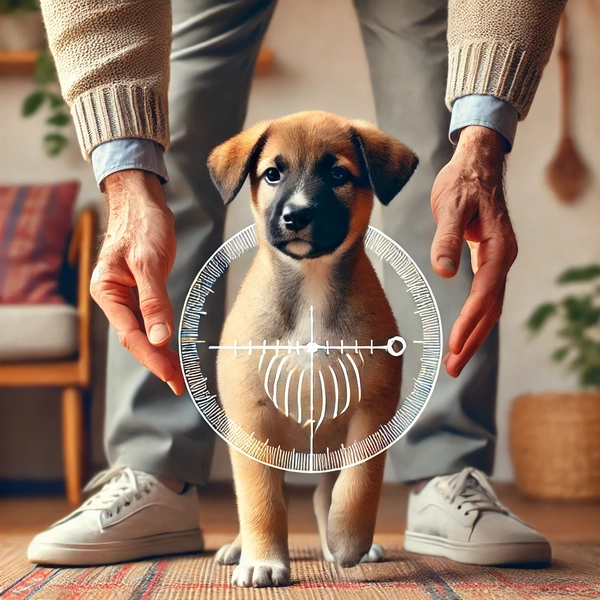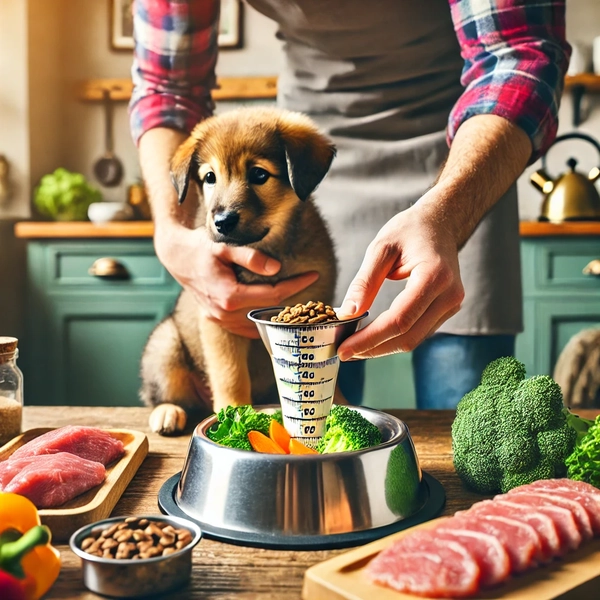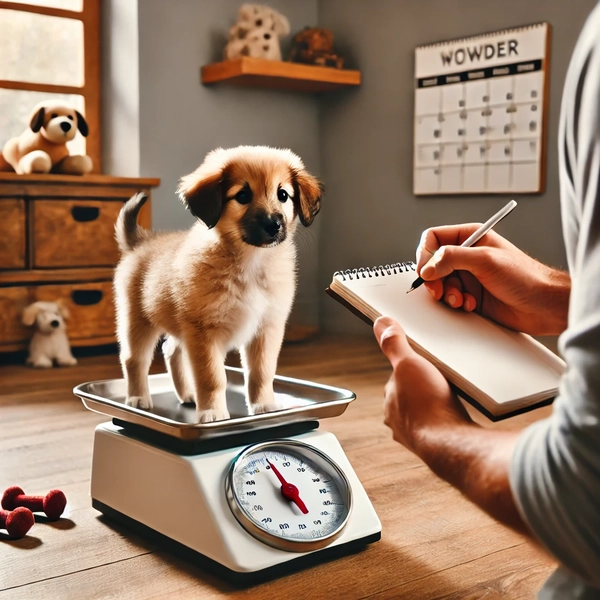How to tell if your puppy is overweight? Moreover, proper healthcare of puppies is crucial for them to continue leading healthy lives. There is also the need for many pet owners to know if their puppy is gaining too much weight.
How to Tell if Your Puppy is Overweight
In simple terms, it can be outlined as follows:
1. Checking Your Puppy’s Appearance

Observing its body shape is one of the most straightforward methods of determining whether a puppy is overweight.
Just like humans, it is recommended that puppies maintain their shape and size.
- Slim Waist: When your puppy is on a level top, you should be able to notice a slight dip or curve, which marks the onset of the waist. If your puppy is more of an egg shape or has no shape at the waist, this could indicate additional tissue in the region of the waist.
- Ribs: Run your hands along your puppies’ ribs. The ribs should be present, although they should not be so prominent in a way they can be seen. When the ribs are absent or are difficult to feel through excessive abdominal fat, these are signs of being obese.
- Safety Measure: Having pets around is comforting because you can always feel and poke them. Doing so also enables you to get accustomed to the average proportions of your pet’s body.
2. Monitoring Eating Habits
As much as puppies enjoy food, giving more than needed can lead to other problems, like weight issues. Here is how you can know when your puppy is overeating.
- Portion Size: Make sure you feed the correct portion, which is determined by the puppy’s age, breed, and activity level. If in doubt, refer to the information provided on the product package.
Begging for Food: Most puppies are fed treats and table food, so it is natural for them to beg, but sometimes, the need to eat out of boredom or starvation sets in, which is unnecessary.
Feeding Guide Table
| Puppy Size | Age (Months) | Portion Size Per Meal (Cups) | Meals Per Day |
| Small | 2-6 | 1/4 – 1/2 | 3 |
| Medium | 2-6 | 1/2 – 1 | 3 |
| Large | 2-6 | 1 – 2 | 3 |
Tip: Puppies require different amounts of food depending on their size and breed. Therefore, always determine the quantity you should feed them in a day.
3. Assessment of Their Activity Level
The amount of activity a growing puppy has is related to its weight, too.
Most puppies are high-energy companions, and if the behavior changes to become less active or more tired, it is a sign of increasing body weight and not a problem of general well-being.
- Playtime: Does your puppy love to move around or force it to sit in one place? Puppies who are lazy and prefer sitting over standing are considered overweight.
- Walks: A puppy that runs out of steam on walks fast and is in seaside discomfort might be carrying extra pounds.
If they do not move as much as an average puppy should, try disrupting their sedentary life by engaging them in more activity, such as playtime or exercises, to promote their fitness.
4. Going to the Clinic for an Examination
Regarding obesity in puppies, no one is more qualified than your veterinarian.
They will look at your puppy, assess it in the overweight section, and compare its actual weight with the ideal weight range for the breed and breeders.
B.C.S. – Body Condition Score: Regarding BCS, vets describe the weight of puppies on a scale of 1 to 9. Lofton dogs’ vertical line or the ideal condition is point 5. Anyway, anything above this line would connote overweight.
| BCS Score | Weight Category | Description |
| 1-3 | Underweight | Bones visible, no fat layer |
| 4-5 | Ideal | Can feel ribs, slight waist |
| 6-9 | Overweight | No waist, hard to feel ribs |
5. Using a Weight Chart for Puppies
Considering that a puppy of a particular breed should weigh a specific amount based on body proportions, it is clear that every breed has an age-appropriate weight range for every member—even puppies.
Recording your puppy’s weight and consulting the graph is very helpful.
Puppy Weight Chart
| Puppy Breed | Age (Months) | Average Weight (lbs) |
| Chihuahua | 3 | 2 – 3 |
| Beagle | 3 | 7 – 9 |
| Labrador | 3 | 15 – 20 |
| German Shepherd | 3 | 17 – 22 |
This is just a reminder that these are averages; therefore, if your puppy is heavier than the indicated range, it may be due to excessive overweight.
6. Signs of Overweight Puppies

Knowing the signs can help you avoid problems related to obesity early. Look for these common indicators:
- Panting more than usual when they are not active.
- Need help to jump onto furniture or climb stairs.
- Excess amount of fat in the chest or the stomach.
7. Adjusting Your Puppy’s Diet

If your puppy presents such symptoms, it might be advisable to amend the diet accordingly.
Adjusting Your Puppy’s Diet
If you feel the puppy is obese, changing its diet will help it lose weight.
- Eliminate Treats: While treats are good, too many could throw you off balance. Cut down on calorie-filled snacks.
- Low Obese Food: Some foods are designed for puppies’ weight-related issues. Suppose you such brands consult your vet.
- Take Pictures of Feed Portions: Portion sizes need to be controlled, and feeding should be on a schedule, so do not leave food out for the entire day.
Suggestion: Use a measuring cup to ensure you give the food the correct amount.
8. Increasing Exercise and Playtime

Exercise remains the critical unifying element for weight control, irrespective of the puppy’s age.
- Walks: Start by going for fun, small walks. As your puppy ages, you can start going for more daily walks.
- Games: Doughnuts or mock village searches are good ways to use these tips. These games help eliminate static energy and immune buildup in the dog’s body.
- Toys: Ropes or balls are active toys played with dogs when they are puppies.
9. Observing Changes Over Time

You must keep checking how much your puppy weighs. This is not done once and is ignored, as it is a steady process of taking measurements at different stages in the future.
- Weigh Monthly: Puppies are known to grow quite fast, and because of this, one should get the weight measured every month to prevent this problem.
- Track Diet and Activity: Write down what the pet eats during the day and its activity level in a diary. This will help you see patterns and make adjustments as needed.
10. Understanding Healthy Weight Maintenance

Having a healthy puppy is about appearing beautiful from its physical shape and being healed overall.
Especially when the pet’s weight is appropriately measured, it would probably not die soon.
- Balanced Diet: Your puppy should get appropriate food that contains the correct elements of proteins, fats, and carbohydrates.
- Regular Exercises: Puppies must be subjected to frequent physical activities to help prevent weakening their joints and muscles. A small, healthy walk can work wonders in the puppies.
- Drinking: Ensure that clean drinking water is always available to your puppy. Adequate water intake helps maintain proper metabolic reactions in the body, which helps digest food.
11. Prevention Tips
Staying away from weight management issues is often better than correcting them. This is how you can differently keep your puppy slim:
- Observe Feeding Schedules: Set times for feeding and observe them. This helps puppies develop good feeding habits.
- Get Appropriate Candies: Coconut makes impossible candies like carrots and apple slices. They are sweet yet not harmful.
- Engage Pet In Games Regularly: Puppies are playful creatures. Set aside time for play daily; otherwise, they will be listless and at odds.
12. When to Seek Professional Help
If you’ve finally reached a stage where you can no longer put your pet through intense activities for days, it’s time to take them to the vet for a checkup.
Some specific disorders need to be ruled out. For instance, idle puppies may gain weight, yet it’s avoidable.
- Thyroid Problems: Occasionally, hormonal imbalances can cause weight gain. It can determine the presence of these issues.
- Digestive Issues: Sometimes, food is not digested in a puppy’s body, preventing its ability to gain weight. A vet will recommend how to correct the problem.
In conclusion, how do you tell if your puppy is overweight? It is sometimes said that keeping a puppy’s weight under check is not just for aesthetic reasons but for the dog’s overall welfare. Growing a healthy and active pup is easy.
Evaluate the weight, food intake, and behavior changes to match that growth rate. Seek help if you see something that needs to be corrected.
Your puppy relies on you for their health, and with some sacrifice for that care, one will have done what is necessary to help the pet live its full potential!